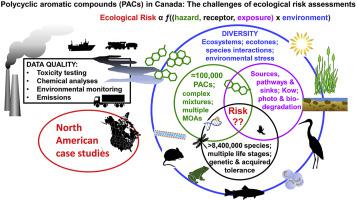Environmental Pollution ( IF 7.6 ) Pub Date : 2020-07-09 , DOI: 10.1016/j.envpol.2020.115165 P V Hodson 1 , S J Wallace 2 , S R de Solla 3 , S J Head 4 , S L J Hepditch 2 , J L Parrott 5 , P J Thomas 6 , A Berthiaume 7 , V S Langlois 2

|
Ecological risk assessments (ERAs) of polycyclic aromatic compounds (PACs), as single congeners or in mixtures, present technical challenges that raise concerns about their accuracy and validity for Canadian environments. Of more than 100,000 possible PAC structures, the toxicity of fewer than 1% have been tested as individual compounds, limiting the assessment of complex mixtures. Because of the diversity in modes of PAC action, the additivity of mixtures cannot be assumed, and mixture compositions change rapidly with weathering. In vertebrates, PACs are rapidly oxygenated by cytochrome P450 enzymes, often to metabolites that are more toxic than the parent compound. The ability to predict the ecological fate, distribution and effects of PACs is limited by toxicity data derived from tests of a few responses with a limited array of test species, under optimal laboratory conditions. Although several models are available to predict PAC toxicity and rank species sensitivity, they were developed with data biased by test methods, and the reported toxicities of many PACs exceed their solubility limits. As a result, Canadian Environmental Quality Guidelines for a few individual PACs provide little support for ERAs of complex mixtures in emissions and at contaminated sites. The issues are illustrated by reviews of three case studies of PAC-contaminated sites relevant to Canadian ecosystems. Interactions among ecosystem characteristics, the behaviour, fate and distribution of PACs, and non-chemical stresses on PAC-exposed species prevented clear associations between cause and effect. The uncertainties of ERAs can only be reduced by estimating the toxicity of a wider array of PACs to species typical of Canada's diverse geography and environmental conditions. Improvements are needed to models that predict toxicity, and more field studies of contaminated sites in Canada are needed to understand the ecological effects of PAC mixtures.
中文翻译:

加拿大环境中的多环芳族化合物(PAC):生态风险评估的挑战。
作为单一同类物或混合物形式的多环芳族化合物(PAC)的生态风险评估(ERAs)提出了技术挑战,令人担忧其在加拿大环境中的准确性和有效性。在超过100,000种可能的PAC结构中,已经测试了小于1%的毒性作为单个化合物,从而限制了对复杂混合物的评估。由于PAC作用方式的多样性,因此无法假定混合物的可加性,并且混合物的组成随风化而迅速变化。在脊椎动物中,PAC被细胞色素P450酶迅速氧化,通常代谢成比母体化合物毒性更大的代谢物。预测PAC的生态命运,分布和影响的能力受到毒性数据的限制,该毒性数据是通过对有限种类的测试物种进行的一些反应测试得出的,在最佳实验室条件下。尽管有几种模型可用于预测PAC毒性和对物种的敏感性进行排序,但它们是通过测试方法有偏见的数据开发的,许多PAC的毒性报告都超过了其溶解度极限。结果,针对一些单个PAC的《加拿大环境质量指南》几乎没有为排放物中和污染场地中复杂混合物的ERA提供支持。通过审查与加拿大生态系统有关的PAC污染场地的三个案例研究,说明了这些问题。生态系统特征,PAC的行为,命运和分布以及暴露于PAC的物种的非化学胁迫之间的相互作用阻止了因果之间的明确联系。只能通过估计更多种PAC对加拿大多样化的地理和环境条件下典型物种的毒性来降低ERA的不确定性。需要对预测毒性的模型进行改进,并且需要对加拿大受污染场所进行更多的现场研究,以了解PAC混合物的生态效应。











































 京公网安备 11010802027423号
京公网安备 11010802027423号